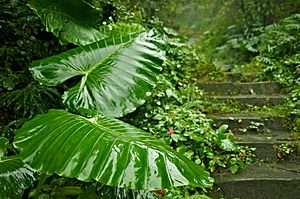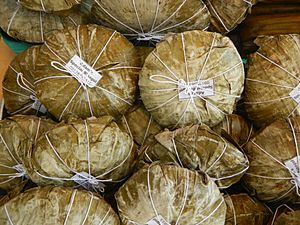Giant taro facts for kids
Alocasia macrorrhizos is a type of flowering plant in the arum family. It originally comes from the rainforests of Island Southeast Asia, New Guinea, and Queensland, Australia. This plant has been grown for a very long time in places like the Philippines and many Pacific islands, as well as other tropical areas.
Some common names for this plant are giant taro, ʻape, giant alocasia, biga, and pia. In Australia, it is also known as the cunjevoi.
Quick facts for kids Giant taro |
|
|---|---|
 |
|
| Scientific classification | |
| Genus: |
Alocasia
|
| Species: |
macrorrhizos
|
| Synonyms | |
|
List
Alocasia cordifolia (Bory) Cordem.
Alocasia indica (Lour.) Spach Alocasia macrorrhizos var. rubra (Hassk.) Furtado Alocasia macrorrhizos var. variegata (K.Koch & C.D.Bouché) Furtado Alocasia marginata N.E.Br. Alocasia metallica Schott Alocasia montana (Roxb.) Schott Alocasia pallida K.Koch & C.D.Bouché Alocasia plumbea Van Houtte Alocasia rapiformis (Roxb.) Schott Alocasia uhinkii Engl. & K.Krause Alocasia variegata K.Koch & C.D.Bouché Arum cordifolium Bory Arum indicum Lour. Arum macrorrhizon L. Arum montanum Roxb. Arum mucronatum Lam. Arum peregrinum L. Arum rapiforme Roxb. Caladium macrorrhizon (L.) R.Br. Caladium metallicum Engl. Caladium odoratum Lodd. Calla badian Blanco Calla maxima Blanco Colocasia boryi Kunth Colocasia macrorrhizos (L.) Schott Colocasia montana (Roxb.) Kunth Colocasia mucronata (Lam.) Kunth Colocasia peregrina (L.) Raf. Colocasia rapiformis (Roxb.) Kunth Philodendron peregrinum (L.) Kunth Philodendron punctatum Kunth Colocasia indica (Lour.) Kunth |
|
Contents
History of the Giant Taro
The giant taro was first grown by people in the Philippines. We know this because wild plants were found by early Austronesians in Taiwan. From the Philippines, the plant spread to other parts of Island Southeast Asia and then eastward to Oceania. It became a very important food crop for Pacific Islanders.
How it Became a Staple Food
Giant taro is one of four main types of aroids (like taros) that Austronesian people grew. They used these plants mainly for their starch. The other important aroids were Amorphophallus paeoniifolius, Colocasia esculenta, and Cyrtosperma merkusii. Each of these had many different types that people grew.
The leaves and stems of the giant taro can also be eaten if they are cooked very well. However, this is not common for giant taro. This is because it has more raphides, which are tiny crystals that can make your mouth and skin feel itchy.
Names Through History
The ancient word for giant taro in Proto-Austronesian was *biRaq. This word later changed to *piRaq in Proto-Oceanic. Today, similar words are used in many languages across Island Southeast Asia and Micronesia. For example, in Rukai it's vi'a or bi'a and in Hawaiian it's pia. Sometimes, these similar words now mean other types of taro plants.
In Australia, Indigenous people had their own names for the plant. These included pitchu in the Burnett River area and cunjevoi in South Queensland. The Yugarabul word for the plant, bundal, is where the name of the suburb Boondall comes from.
Uses of Giant Taro
The giant taro can be eaten if it is cooked for a long time. However, its sap can irritate the skin. This is due to tiny, needle-like crystals called raphides. Plants that are harvested later tend to have more of these crystals.
Food and Traditional Uses
Alocasia species are often sold in markets in Samoa, Tonga, and other parts of Polynesia. In Tahiti, different types are known as Ape oa, haparu, maota, and uahea. There is a Hawaiian saying: ʻAi no i ka ʻape he maneʻo no ka nuku. This means "The eater of ʻape will have an itchy mouth." It's a way of saying that doing something bad will have consequences.
The very large, heart-shaped leaves of the giant taro can be used as quick umbrellas during tropical rainstorms.
Traditional Cooking Method
In 1866, Anthelme Thozet wrote about how people prepared the plant. He explained that young bulbs, which are light pink inside, were found on older plants. These were scraped, cut in half, and cooked under hot ashes for about 30 minutes.
After baking, they were pounded between two stones. Any watery pieces were thrown away. The good pieces were then put back in the fire. This process was repeated many times. Eventually, the hakkin, which turned a green-grey color, would harden and be ready to eat.



